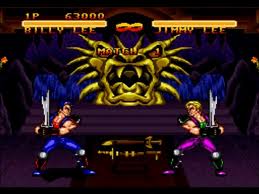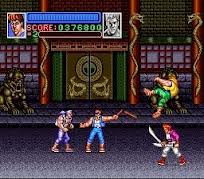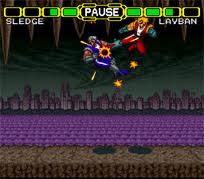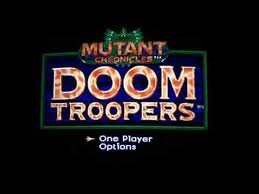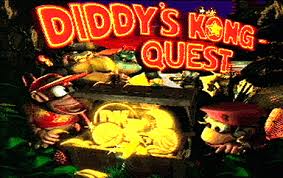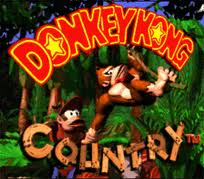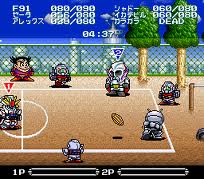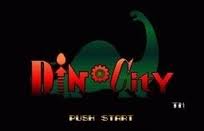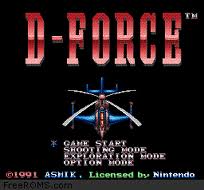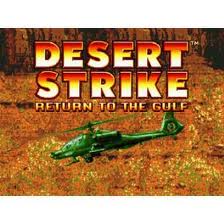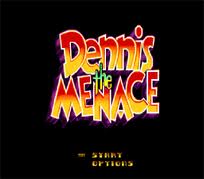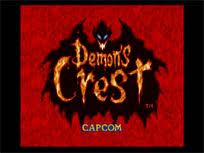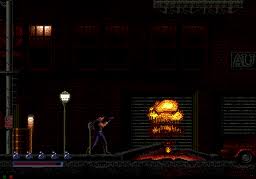Category: Action
732 game(s)All Action games for SNES
Double Dragon 5 - The Shadow Falls
Double Dragon V: The Shadow Falls is a 1994 American-produced sequel to Technōs Japan's Double Dragon series.[4] Unlike the previously produced Double Dragon games, Technōs had little or no credited involvement in the development of the game outside of licensing the series' name to publisher Tradewest (the publisher of the first NES version of Double Dragon and the Super NES title Super Double Dragon). Instead, the game was developed by Leland Interactive Media, a subsidiary of Tradewest. Unlike the previous games, which were side-scrolling fighting action games or beat-em-ups, Shadow Falls is a head-to-head fighting game based on the animated Double Dragon TV series in the style of Capcom's 1991 arcade-hit Street Fighter II. Technōs would later produce its own fighting game based on the Double Dragon movie the following year simply titled Double Dragon for the Neo Geo. Shadow Falls was originally released for the Super NES and Sega Mega Drive/Genesis, and later released for the Atari Jaguar by Telegames (publisher of the Atari Lynx version of the first Double Dragon) in 1995.
Double Dragon 2
Doomsday Warrior
Doomsday Warrior, known in Japan as Taiketsu!! Brass Numbers (対決!!ブラスナンバーズ lit. "Confrontation!! Brass Numbers"?), is a 1992 Super NES fighting game developed and published by Telenet Japan's subsidiary Laser Soft in Japan on November 20, 1992 and later localized by Renovation Products in North America on March 1993. It was created during the fighting game trend of the 1990s that was popularized by Capcom's Street Fighter II.
Mutant Chronicles - Doom Troopers
Doom Trooper is a collectible card game designed by Bryan Winter. It is based on concepts from the Mutant Chronicles franchise. Players use warriors to attack and gain either Promotion Points or Destiny Points. Promotion points can be used to win; Destiny Points are used to purchase more warriors and equipment. There are 13 different card types and over 1100 different cards available.
Doom Trooper was originally published by now defunct Target Games.
Donkey Kong Country 3 - Dixie Kongs Double Trouble
Donkey Kong Country 3: Dixie Kong's Double Trouble! is a platform game developed by Rare and published by Nintendo and was the final installment in the Donkey Kong Country series until Nintendo announced Retro Studios would be reviving the series and developing the next installment, Donkey Kong Country Returns, for the Wii. It was released in late 1996 for the Super Nintendo Entertainment System. The game was ported to Game Boy Advance in 2005 with a different soundtrack. The title was released on the Wii's Virtual Console service in North America on December 24, 2007, and the following day in Europe as a special Christmas update (no longer available as of November 25, 2012).
Donkey Kong Country 2 - Diddys Kong Quest
Donkey Kong Country 2: Diddy's Kong Quest (abbreviated to DKC2) (スーパードンキーコング2 ディクシー&ディディー Sūpā Donkī Kongu Tsū: Dikushī & Didī?, Super Donkey Kong 2: Dixie & Diddy) is a 1995 adventure platform game developed for the Super Nintendo Entertainment System (otherwise known as the "SNES") produced by Rareware and published by Nintendo - with Diddy Kong and Dixie Kong starring as the main characters of the game. Donkey Kong Country 2 was first released on November 20, 1995 in North America. Donkey Kong Country 2 is a sequel to the original Donkey Kong Country (1994) which was later followed by Donkey Kong Country 3: Dixie Kong's Double Trouble! (1996). DKC2 was later also released on the Game Boy Advance in 2004 and was until recently available for download on the Wii's Virtual Console, having become one of the most popular games of its age.
The game begins soon after Donkey Kong has been kidnapped by the prime antagonist Kaptain K. Rool, leaving Diddy and his girlfriend Dixie to rescue him. Together, the two travel to various and distinct parts of Crocodile Isle where the game is set on which there are varying worlds totalling in eight unique environments.[3] Improved over its predecessor, DKC2 was praised for having excellent graphics, plot and characterisation and as a result DKC2 received much critical and commercial praise. Selling millions of copies worldwide on the SNES, it was the second best selling game of 1995 and the sixth best-selling game on the platform overall.
Donkey Kong Country
Donkey Kong Country is a platform video game developed by Rare that was originally published for the Super Nintendo Entertainment System. It was first released on November 21, 1994, in North America and on November 24, 1994, in Europe. Donkey Kong Country was the first Donkey Kong game that was not produced or directed by Shigeru Miyamoto, the character's original creator. It was produced by Tim Stamper instead, although Miyamoto was still involved with the project.
Following an intense marketing campaign, Donkey Kong Country received very high critical praise and sold over nine million copies worldwide, making it the second-best-selling Super Nintendo game. The game was later re-released for the Game Boy Color on November 4, 2000, the Game Boy Advance on June 9, 2003, and the Virtual Console on February 19, 2007. The game, along with its sequels, were taken off the Virtual Console on November 16, 2012, in the United States without notice, and November 25, 2012, in Europe.
Donald Duck - Maui Mallard in Cold Shadow
Dodgeball
Dino City
DinoCity, originally released in Japan as Dinowars Kyōryū Ōkoku e no Daibōken (ダイナウォーズ 恐竜王国への大冒険?, "Dinowars: Adventures in the Dinosaur Kingdom"), is a platform video game developed and published by Irem Corporation for the Super Nintendo Entertainment System.
The game is loosely based on the 1991 television American film Adventures in Dinosaur City by Smart Egg Pictures, and borrows many of the film's characters, settings, and basic plot while providing its own unique art direction and style. Initially released in July 1992 for Japanese audiences, the game was later made available in North America the following September. The game centers on Timmy and his friend Jamie, two young children who are accidentally transported to a world resembling prehistoric Earth populated by anthropomorphic dinosaurs. While a device which will allow them to return home exists in this environment, a critical component has been stolen by Mr. Big, leader of a gang of Neanderthals known as The Rockeys, leaving the player to guide Timmy or Jamie to his castle to retrieve it. They are assisted by Rex, a Tyrannosaurus, and Tops, a Protoceratops, each with their own play-styles.
D-Force
D-Force, known in Japan as Dimension Force (ディメンションフォース?), is a 1991 vertical scrolling shooter video game developed and published in Japan by Asmik for the Super Famicom and later localized and published in North America by Asmik Corporation of America for the Super NES. It involves an Apache helicopter set on defeating an evil Middle Eastern dictator. There are seven levels which feature six countries. Some of the levels involve switching altitudes in order to attack enemies from a different height, which uses Mode 7, one of the main features of the Super NES.
Desert Strike - Return to the Gulf
Desert Strike: Return to the Gulf, commonly known as Desert Strike, is a shoot 'em up video game released by Electronic Arts (EA) in February 1992 for Sega's Mega Drive.[1] The game was later released on several other formats such as the SNES, including a much upgraded version for the Amiga home computer. The game was inspired by the Gulf War and depicts a conflict between an insane Middle Eastern dictator, General Kilbaba, and the United States. The player controls a lone Apache helicopter and attempts to destroy enemy weapons and installations, rescue hostages and capture enemy personnel, while managing supplies of fuel and ammunition.
The lead designer, Mike Posehn, had no video game experience prior to developing Desert Strike. Inspired by Choplifter, he aimed to create a nonlinear game with smoothly animated vehicles. Posehn, a PhD in Mechanical Engineering, developed a camera system with momentum to mimic realistic helicopter movements. Three-dimensional (3D) modeling was used to generate the vehicle sprites, which were later touched up on the pixel level with color.
Desert Strike was a strong commercial success: it was a chart-topping best seller and at the time Electronics Arts' highest ever selling game. The game also received a favourable critical response, with several magazines awarding scores of over 90%. Reviewers praised the game's enjoyability, mix of action and strategy, graphics and sound. There was some controversy regarding the game's subject matter, with commentators criticising it as in poor taste due the proximity of its release to the recently ended Gulf War.
Dennis the Menace
Demon's Crest
Demon's Crest (Japanese: デモンズブレイゾン 魔界村 紋章編 Hepburn: Demonzu Bureizon Makaimura Monshō-hen?, "Demon's Blazon: Demon World Village Crest Volume"), is a side-scrolling platform video game developed and published by Capcom for the Super Nintendo Entertainment System. It is the third video game starring Firebrand (an enemy character from the Ghosts 'n Goblins series, known as "Red Arremer" in the Japanese version), following Gargoyle's Quest and Gargoyle's Quest II.
Demolition Man
Demolition Man is a pair of action video games based on the film of the same name. Acclaim Entertainment published the 16-bit version, which features run and gun gameplay, for the Super NES, Sega Genesis and Sega CD. Virgin Interactive released a completely different game for the 3DO that combined several distinct gameplay styles. In both games, the player controls John Spartan, the main character from the film, as he attempts to find and defeat his nemesis, Simon Phoenix.
